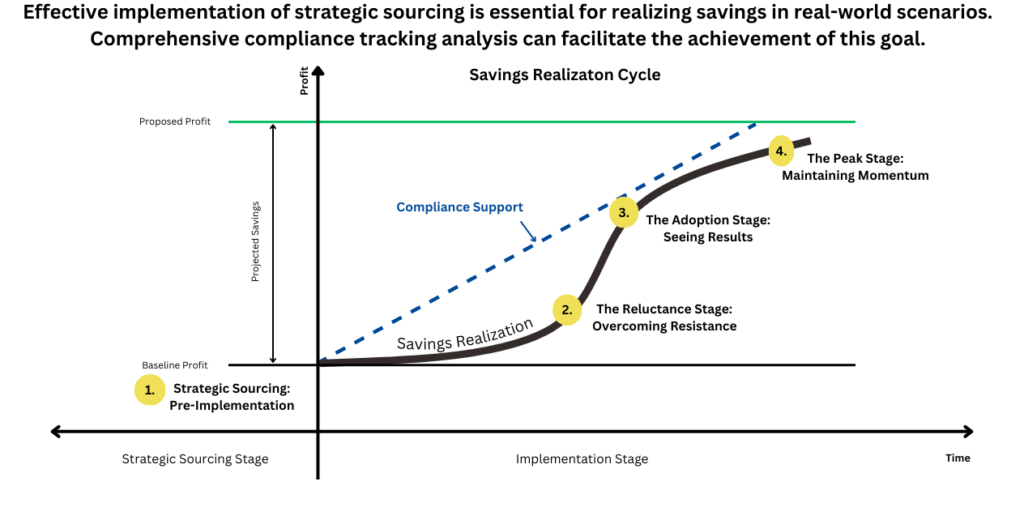
Have any questions Submit an Inquiry

Healthcare providers worldwide encounter obstacles in optimizing their supply chains due to costly provider preference items with narrow profit margins. The clash between healthcare providers and strategic teams over the utilization of alternative brands with similar clinical outcomes is a perennial challenge. Despite successful negotiations with multiple vendors and the careful selection of optimal purchase plans, translating these efforts into actual savings poses significant hurdles. The complexity of numerous categories, baseline assumptions, and resistance from healthcare providers impedes the realization of projected savings from strategic sourcing efforts.
Bridging the gap between savings projections and actual realization demands a comprehensive approach starting with measurement, because, as the adage goes, “If you can’t measure it, you can’t control it — and you certainly can’t fix it.”
Implementing a robust compliance tracking process is essential to realizing projected savings on the ground as envisioned during strategic sourcing. Typically, this involves four major stages in the savings lifecycle.

In this stage, sourcing team performs the strategic sourcing process, a comprehensive and systematic approach to procurement. Supported by data-driven decision-making, market intelligence, and procurement analytics tools, sourcing team negotiate with vendors and identifies ultimate brands mix that can maximize profit and/or minimize the cost. Groupwise List of shortlisted brands are shared with healthcare provides to prescribe it and profit from proposed brand mix considered as target. In the graph, the green line represents the proposed profit, while the black line represents the baseline established through group-wise analysis of current profits. At the end of this stage all the necessary approvals are taken from relevant stakeholders & initial set up for implementation is completed.
This is the initial phase of implementation of any cost-saving or profit-increasing initiative, and it’s often the most challenging. Healthcare providers initially resist to prescribe the suggested brands identified through strategic sourcing, preferring their individual preferences, leading to minimal initial savings realization. So, in this stage actual savings realization curve remains almost near to the baseline. Majority of the new initiative struggle to navigate and not able survive through this stage, which typically extends over a significant period.
Convincing healthcare providers to adopt suggested brands demands substantial effort during this stage, with the ratio of savings realised to effort required often being minimal. The slope of actual savings realization remains nearly flat, running parallel to the horizontal line.
Surviving this phase necessitates constant collaboration between healthcare providers and the operational team. The operational team must receive robust backend support from the compliance analysis team to bolster their arguments. Initially, the compliance analysis team strategically narrows down to one or two most impactful suggestions, emphasizing low-hanging fruits that can be readily implemented. Insights gleaned from compliance analysis play a pivotal role in this stage and can effectively shorten its duration.
At this stage, the efforts invested in the previous phase begin to yield results. Doctors gradually accept and adopt the suggestions put forth by the strategic team, propelling the actual savings realization curve to upward with a positive slope. Early in this stage, even adopting one or two higher-margin suggested brands can yield significant realization of projected savings due to the high potential for improvement. Consequently, the actual savings realization curve exhibits a trajectory almost parallel to the vertical axis within a relatively short time span.
Backend actionable insights from compliance analysis play a pivotal role during this phase, shaping the trajectory of the savings realization curve. The slope of the savings realization curve in this stage depends on various factors, including target categories, organizational culture, support from top management, adoption rate, and more. However, with robust backend support from the compliance analysis team and a motivated operational team, a positive slope for savings realization can be achieved across almost all categories.
At this stage, since a small number of brands yielding the majority of savings were already addressed in the previous stage, the remaining brands offer lower potential for savings realization. Consequently, the slope of the actual savings realization curve diminishes compared to the previous stage. This stage typically extends over a longer period of time. Despite the reduced savings opportunities at this stage, active tracking of savings compliance is crucial to maintaining a higher level of adherence. Failure to accurately measure compliance during this stage may cause the actual savings realization curve to begin slipping downward, with the slope turning negative as doctors revert to prescribing their preferred brands out of habit.
Organizations can sustain peak performance by either perpetuating the current implementation process or initiating a new cycle from this point, possibly by introducing new categories into the existing framework.
The duration of each stage outlined may vary based on different objectives and categories. Insights derived from savings compliance analysis are indispensable throughout the entire lifecycle of a savings initiative’s implementation. At EmpoweringCPO, our forte lies in offering a comprehensive solution tailored to assist organizations in fully realizing their projected savings at the operational level, thereby positively influencing their actual profit and loss accounts. Utilizing our proficiency in data modeling, analytics, and sophisticated number crunching, we create a procurement savings tracker that offers profound insights into each phase of the savings realization lifecycle. This tool not only identifies areas of non-compliance but also proposes strategies to enhance savings realization. Our service is customized to meet each client’s specific requirements, ensuring an approach that tackles particular challenges and secures measurable outcomes.
EmpoweringCPO is a team of experienced sourcing and procurement professionals with hands on experience of having worked with many fortune 500 companies. The company was founded in 2011 and since then has executed multiple strategic sourcing projects and have achieved average savings of 10-12% so far. In addition to Strategic Sourcing their other offerings are Spend Analysis, Procurement Intelligence, Procurement Analytics, Best Cost Country Sourcing, Procurement Outsourcing, Built Operate Transfer, Supplier Diversity, Sustainable Procurement, Tail Spend Management, Item Master Optimization, Collective Buying, Compliance Tracking and Managed Procurement Services.
Compliance management is very critical as otherwise the procurement organization may run into a scenario where there is a huge gap between realized savings and reported savings. Many procurement functions estimate large savings numbers when contracts are signed. They also invest significant time and effort in negotiating contracts for necessary goods and services, only to have a third or more of their purchasing dollars flow outside those deals. Some of the obvious fall-outs of non-compliance and maverick purchases are:
As compared to the current contract that was finalized after the sourcing process, the tool helps in tracking:
The objective of this tool is to ensure that the orders are placed only with the vendors that were shortlisted after the sourcing process and at the same price that was agreed upon and negotiated during and after the strategic sourcing process.